In the horse world, there’s no more classic-looking horse than the Pinto. Pinto horses have patterned coats that combine large areas of white and another basic coat color. Pintos can have a wide variety of patterns, but three of the most common ones are the tobiano, the overo, and tovero patterns.
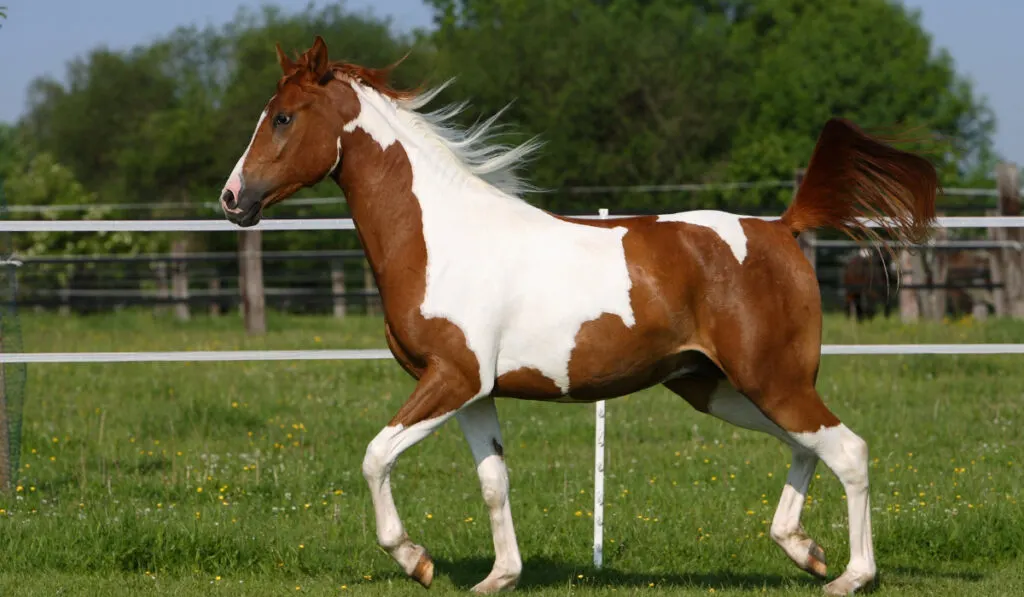
The tobiano pattern consists of regular oval or circular color marks that cover the chest and neck, with the legs being generally white.
In the overo pattern, the white is more irregular and generally one or all four legs are dark.
Horses with the tovero pattern sometimes have blue eyes, are mainly white, and have irregular color spots in the chest, flank, and base of the tail.
Some horses that often have Pinto coats include the American Saddlebred, the Gypsy Horse and the Icelandic Horse. Some, like the Spotted Saddle Horse and the Spotted Draft Horse, are always Pinto.
Paint and Pinto Horses are often confused. While Pintos can be of many breeds, Paint Horses are a distinct breed. There is much to love and learn about Pintos, so read on to learn more about this wonderful color breed!
Table of Contents
1. American Saddlebred
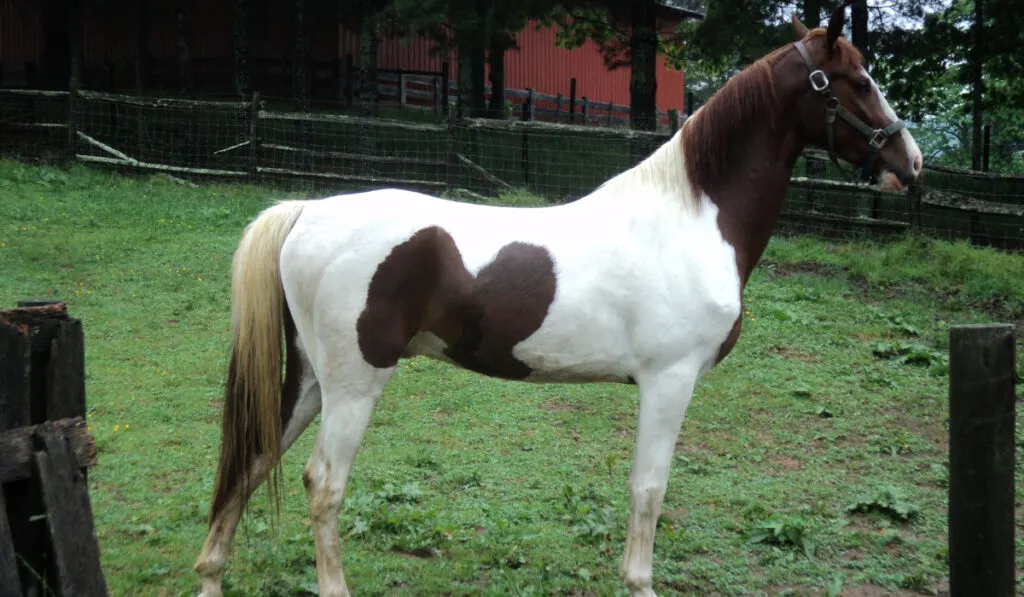
A true American breed, the American Saddlebred is referred to as the “horse that America made.”
Developed in the 1700s, the breed is the result of the crossing of Thoroughbreds with the Narragansett Pacer. Now extinct, the Narragansett Pacer is considered to be America’s first true breed.
American Saddlebreds became very popular and by the next century, they played an important military role as the horses of choice for some key characters in the Civil War, including the General Robert E. Lee and soldier and future U.S. president Ulysses S. Grant.
Today, aside from their fascinating history, American Saddlebreds are known for their versatility and they make powerful but graceful show ring horses as well as excellent trail riding mounts.
American Saddlebreds are either three-gaited or five-gaited: the three-gaited Saddlebreds perform the animated walk, trot, and canter, and the five-gaited two additional ones, the slow gait and rack.
American Saddlebreds can be almost any coat color, including pinto. Together with their light and elegant conformation, a pinto American Saddlebred is a striking vision to hold.
2. Gypsy Horse
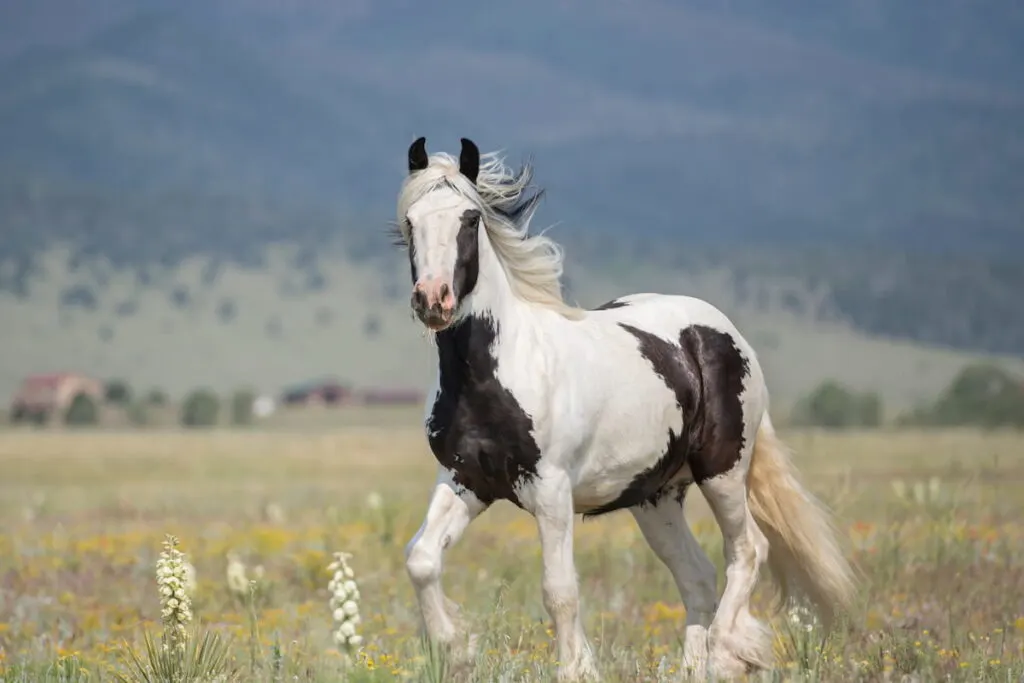
The Gypsy Horse originated in Great Britain and Ireland, where the Roma, a traditionally traveling people, breed a horse that could pull the caravans they rode across the country in.
These wonderful and even-tempered horses can be of many colors, but they often have a piebald or skewbald pattern coat.
A piebald horse has white markings on black base coat, while a skewbald has white markings on any other colored coat, usually chestnut or bay.
You will recognize a Gypsy Horse by their smaller size, the heavy feathering on their legs, and their abundant manes and tails.
Though bred for their strength, Gypsy Horses are also used for riding, and they are happy in both Western and English riding styles.
Because Gypsy Horses are known for their kind, sensible, and willing temperament, they make for a popular family horse today.
3. Miniature Horse
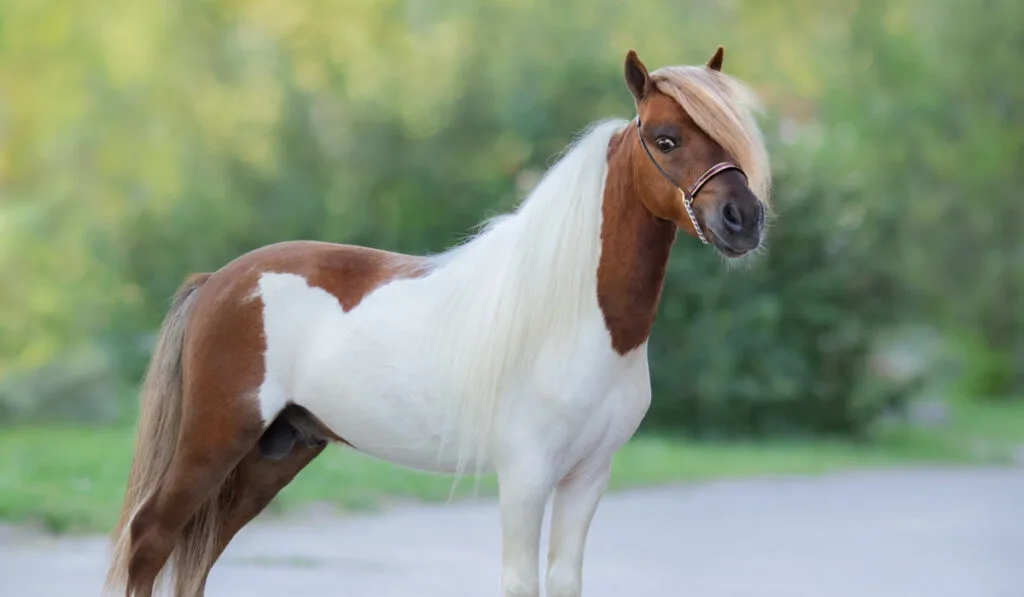
As their name indicates, the Miniature Horse is a small breed of horse. They usually stand no higher than 38 inches. Descended from Shetland Ponies, Miniature Horses are incredibly strong–they are able to pull four times their weight!
Miniature Horses are the result of centuries of careful breeding and while one of their earlier uses was as working mine horses (chosen due to their small size), they also became a symbol of status for royalty.
Miniature Horses are intelligent, curious and social and they make wonderful companions.
One thing to keep in mind with Miniature Horses is that they are prone to obesity, either due to overfeeding or more limited opportunity to exercise.
A way to recognize a Miniature Horse is that they look exactly like an average size horse, only reduced in size. Ponies, with which Miniature Horses are sometimes confused, are stockier with shorter legs.
Another way to identify Miniature Horses, other than their size, is their thick coats and abundant manes and tails.
4. Paint Horses
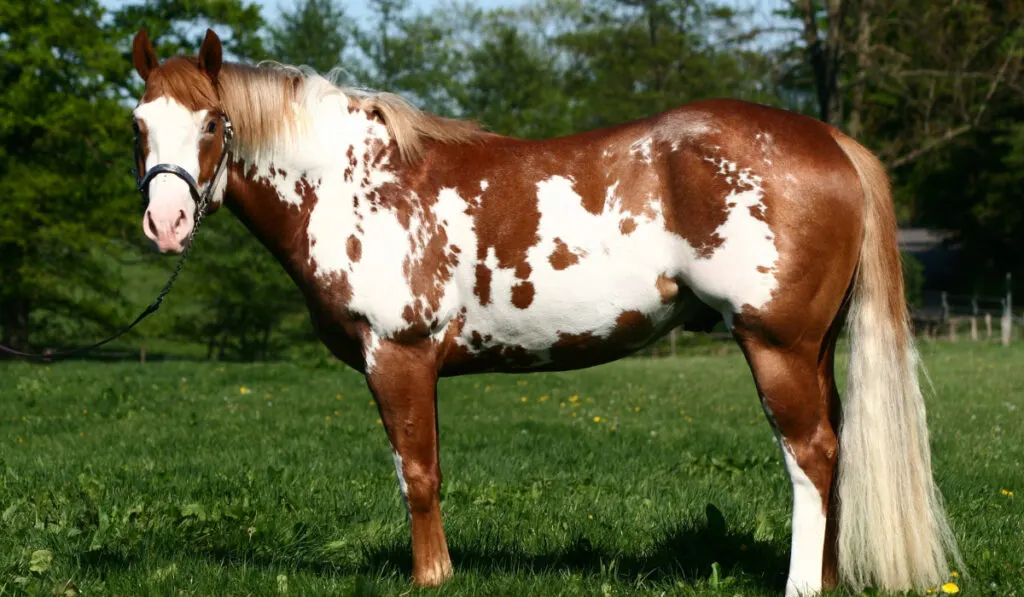
Unlike Pintos, which are a color breed, Paints are a horse breed recognised by the American Paint Horse Association. In order to be registered as Paint, horses have to have a pinto coat and a verifiable pedigree as Quarter Horses or as Thoroughbreds.
Paint Horses can have a wide range of combinations of white and another color, including black, chestnut, bay, brown, dun, grulla, grey, buckskin, and even palomino. As a breed of Pintos, Paint horses can also display the tobiano, overo, and tovero color patterns.
Paints’ confirmation shows their heritage, as they are strong, muscular horses whose low center of gravity gives them great balance, a reason why they are such wonderful trail horses. Paints with Thoroughbred heritage tend to be taller.
Paints are one of the most popular breeds around the world, not only due to their spectacular markings, but thanks to their easy going temperament and versatility – you will find them at ease both in Western and English disciplines.
(Source).
5. Spotted Saddle Horse
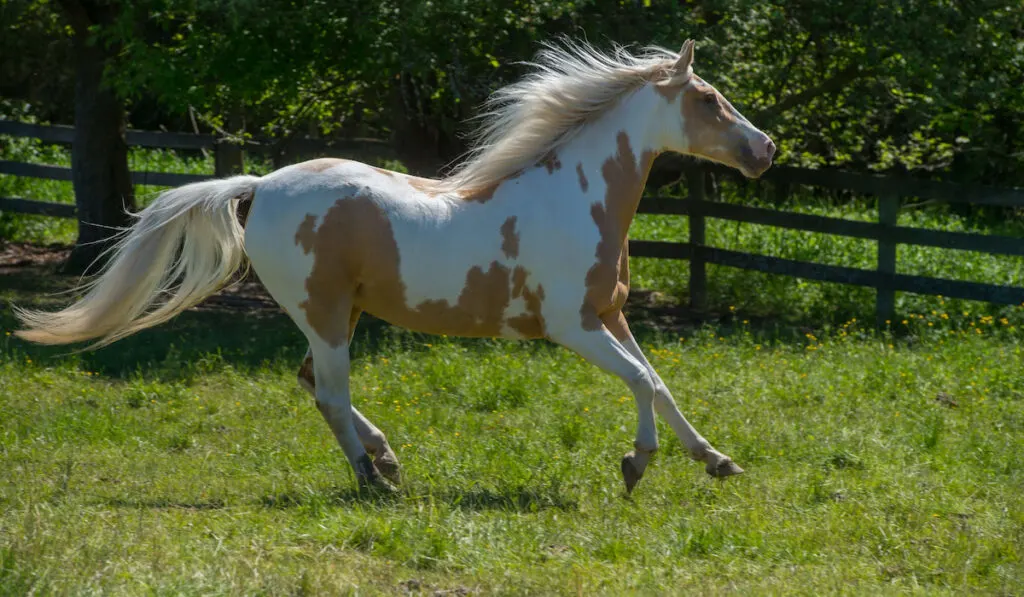
The Spotted Saddle Horse is a natural gaited breed originating from the crossing of Spanish pinto ponies and other American breeds such as the Morgan and the Tennessee Walking Horse.
The breed in fact originated in Tennessee as a light, family riding horse used for pleasure and trail riding.
Today, the breed maintains the beauty and gentleness of disposition of the spotted pony as well as the athleticism of the Tennessee Walking Horse. Spotted Saddle Horses are medium size with long, elegant limbs.
In addition to their natural gait, Spotted Saddle Horses are known for their coats, which can be in almost any color in combination with white and usually in either the tobiano or overo patterns.
However, the color pattern of each Spotted Saddle Horse is unique, which makes for an exciting breed to ride and behold for any horse lover.
6. Spotted Draft Horse
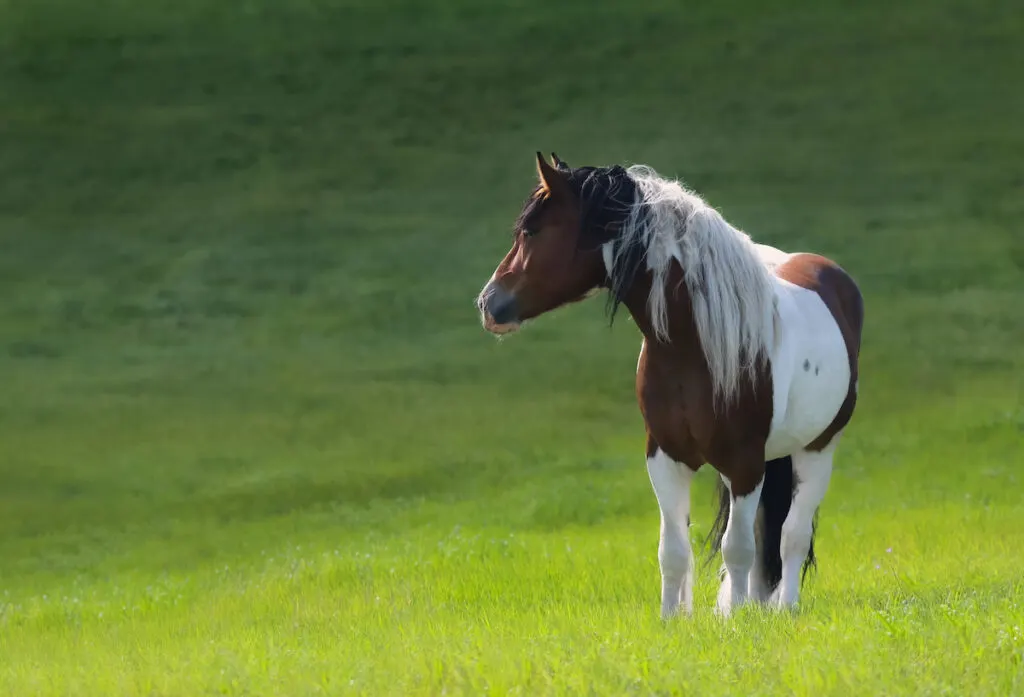
The Spotted Draft Horse is a relatively recent breed originally of America. As its name indicated, Spotted Draft Horses have a pinto color coat and draft horse characteristics.
According to the North American Spotted Draft Horse Association, Spotted Draft horses are built for “more power than action.” What distinguishes the breed are its combination of pinto coloring and their draft horse conformation: large frame, with short and muscular thighs and short and strong backs.
This horse is also known for its gentle temperament, willingness to work, especially in pulling heavy loads, and its “heart.”
While Spotted Draft Horses can have any combination of white and another coat color, most commonly they are a combination of white and black, bay, and brown. Their pinto coats are usually a combination of 40% spots and 60% base coat color.
Click here to learn more about this wonderful and unique breed!
(Source). (Source).
7. Icelandic Horse
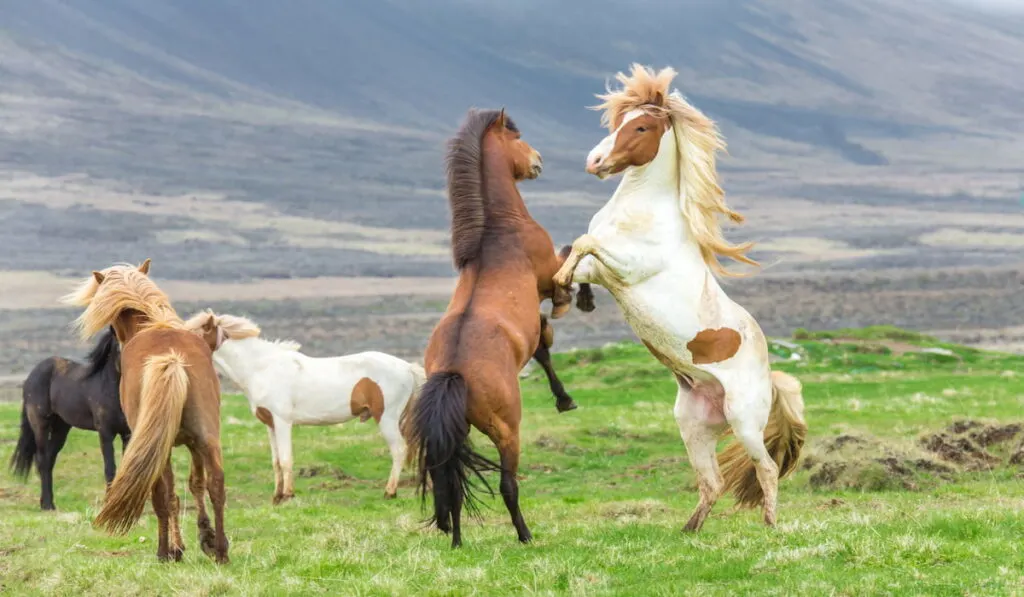
Icelandic Horses descend from the horses brought to Iceland by Norse settlers over 11 centuries ago.
Over time, these horses adapted to the cold and harsh climate of the country and due to their isolation, the breed has remained relatively pure. The Icelandic Horse of today is also the result of careful breeding over the centuries.
Traditionally, Icelandic Horses were raised in herds or free range. The lack of natural predators in their environment also helped shape the Icelandic Horse’s personality: today they are known for their calm, friendly, and gentle temperament: they are not easily spooked.
Icelandic Horses have thick winter coats that they shed in the spring, and can be of almost any color, including of course, pinto.
They have five gaits: the standard walk, trot and canter as well as the “tölt” and the “skeið.” The skeið, known as “flying pace,” is a very fast, two-beat lateral gait that makes the rider feel as if they are flying.
Deeply ingrained in the history and folklore of Iceland, Icelandic Horses are a beloved and unique breed.
Sources
When learning about horses, it is important to consult a variety of sources. These are the sources used in this article.
- https://apha.com/
- http://afs.okstate.edu/breeds/horses/paint/index.html/
- https://www.horseillustrated.com/horse-exclusives-paint-vs-pinto
- https://www.newenglandhistoricalsociety.com/narragansett-pacer-lost-horse-new-england-colonies/
- https://www.asha.net/aboutus/theamericansaddlebred/breedinformation/
- https://www.thesprucepets.com/american-saddlebred-horse-breed-profile-4783512
- https://thehorse.com/115070/the-miniature-horse-more-than-just-a-smaller-horse/
- https://www.thesprucepets.com/meet-the-miniature-horse-1886135
- http://afs.okstate.edu/breeds/horses/paint/index.html/
- https://www.gibsonhorses.com/blog-1/the-american-paint-horse
- http://nssha.com/about/
- http://imh.org/exhibits/online/breeds-of-the-world/north-america/spotted-saddle-horse/
- https://www.equisearch.com/articles/spotted-saddle-horse-breed
- https://sites.google.com/site/naspotteddrafthorseassn/about-us/breed-description
- https://www.horsebreedspictures.com/spotted-draft-horse.asp
- https://guidetoiceland.is/nature-info/the-icelandic-horse-a-comprehensive-guide
- http://afs.okstate.edu/breeds/horses/icelandic/index.html/
- https://www.gibsonhorses.com/blog-1/the-american-paint-horse

